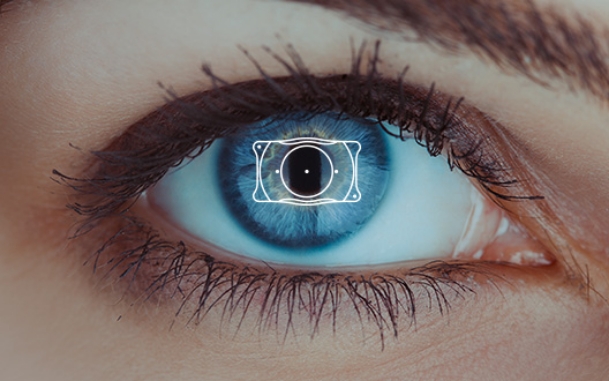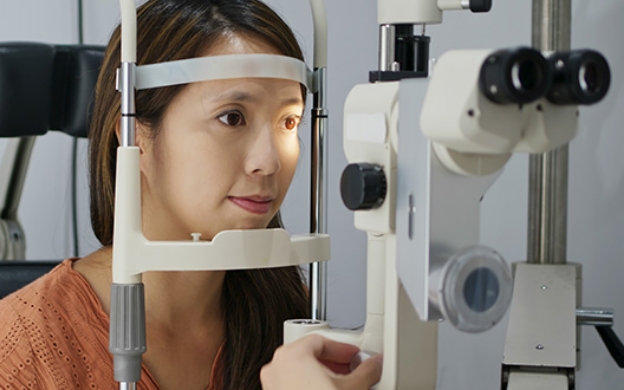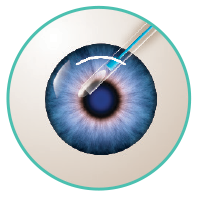
Understanding Changes in Your Vision
Many of us experience refractive errors such as nearsightedness, farsightedness, and astigmatism over our lives, causing our vision to be distorted and requiring glasses or contacts to see clearly. Some of us have enjoyed great natural vision their whole lives but notice changes in their vision after the age of 40.

Presbyopia
After the age of 40, the natural lens of your eye starts to lose its flexibility, making it difficult to focus over a range of distances. This condition is called presbyopia, a natural aging process of the eye.
You may find that you need to use over the counter reading glasses or remove your glasses or contact lenses to see up close. Others may need to rely on monovision contact lenses, bifocals, or trifocals in order to see clearly at all distances. Regardless, these changes begin to affect your active lifestyle.
What is RLE?
RLE, also referred to as clear lens exchange or refractive lensectomy, is a procedure that replaces the eye’s clear natural lens with an Advanced Lifestyle Lens to correct refractive errors (nearsightedness, farsightedness, astigmatism) while also correcting presbyopia. The procedure provides options for vision to match your lifestyle, including providing a full range of vision while greatly reducing the need for glasses and contacts. Another great benefit of having RLE surgery is that because your natural lens has been permanently replaced with an Advanced Lifestyle Lens, you will never need cataract surgery in the future!

If you’re over 45 and have not developed cataracts, and want to see clearly without the constant need for glasses or contacts, RLE may be right for you. Meet with our experts to determine if RLE is right for you.
Lasting Benefits of RLE

Quick Procedure
No stitches & quick recovery

Outstanding Results
Excellent visual results with little to no dependence on glasses

Permanent Correction
Will never need cataract surgery
RLE Surgery

Today’s RLE Surgery – Clear Vision is In Sight!
Today, Refractive Lens Exchange (RLE) is easier and more precise. Our goal is to provide you with options designed to provide you with a full range of vision with less dependence on glasses and contacts for your active lifestyle.
What to Expect
Before Refractive Lens Exchange surgery is scheduled, you will meet a refractive coordinator who will discuss the procedure with you and answer any questions you may have. Your refractive coordinator will perform a thorough eye exam to determine if you may be a possible candidate. If you are a good candidate, you will then meet with your surgeon to further examine your eye and discuss the Advanced Lifestyle Lens options based on your visual goals and lifestyle. At The Eye Center, each patient is given their own Vision Care Specialist that will take their unique measurements, review the procedure in detail, and aid throughout the pre-operative process.

Step-By-Step
Refractive Lens Exchange is performed just like advanced cataract surgery, there are no injections and no stitches. You may be given mild medication to relax you, and you’ll be awake and comfortable. Recovery is quick – you may resume most activities the next day.
Step One

The procedure is usually performed in about 15 minutes. In addition to numbing drops, you’ll be given IV relaxation medicine.
Step Two

After making a small incision, our doctors insert a probe to break up and gently remove the inflexible natural lens.
Step Three

The flexible advanced lifestyle lens is folded up and inserted into the lens capsule. It then opens and its haptics, or “arms” unfold to keep it in place.
Advanced Lifestyle Lens
With RLE and Advanced Lifestyle Lenses, you may be able to enjoy all of your activities with little to no dependence on glasses, contacts, or reading glasses!
You Have Questions, We Have Answers!
Click below to view FAQ’s about RLE surgery
Recovery After RLE Surgery
After surgery, you’ll be prescribed eye drops that guard against infection and aid in the healing process. It is very important to follow the eye drop schedule given by your surgeon and Vision Care Specialist. Avoid rubbing your eyes, lifting heavy objects, and swimming for the first two weeks following surgery. Every patient will go through a series of post-op visits for several weeks following surgery to make sure the eye is healing properly.
Recovery time after surgery is generally quick and usually occurs within a few days. Most patients notice better vision soon after surgery and continue to see improvement in their vision over the following weeks.

Right After Surgery:
Cloudy, blurry close-up, and halos and starbursts

Days After Surgery:
Distance improved, near still blurry, night vision halos

Weeks After Surgery:
Near is improving, night vision Improving

Months After Surgery:
Night Vision problems still improving
